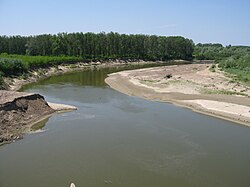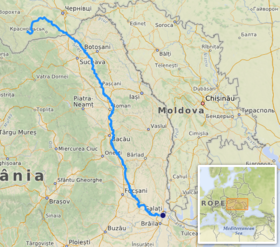Siret (river)
 From Wikipedia - Reading time: 8 min
From Wikipedia - Reading time: 8 min
| Siret | |
|---|---|
 Siret River at Mircești | |
 Path of the Siret [1] | |
| Location | |
| Country | |
| Counties/ Oblasts | |
| Cities | |
| Physical characteristics | |
| Source | Eastern Carpathians |
| • location | Chernivtsi O., Ukraine |
| • elevation | 1,238 m (4,062 ft) |
| Mouth | Danube |
• location | Galați |
• coordinates | 45°24′11″N 28°1′27″E / 45.40306°N 28.02417°E |
| Length | 647 km (402 mi) |
| Basin size | 44,811 km2 (17,302 sq mi) |
| Discharge | |
| • average | 250 m3/s (8,800 cu ft/s) |
| Basin features | |
| Progression | Danube→ Black Sea |
| Tributaries | |
| • left | Bârlad |
| • right | Suceava, Moldova, Bistrița, Trotuș, Putna, Buzău |
The Siret or Sireth (Ukrainian: Сірет or Серет, Romanian: Siret pronounced [siˈret], Hungarian: Szeret, Russian: Сирет) is a river that rises from the Carpathians in the Northern Bukovina region of Ukraine, and flows southward into Romania before it joins the Danube.[1][2] It is 647 km (402 mi) long,[3]: 9 of which a 559 km (347 mi) section is in Romania,[2][3]: 9 [4] and its basin area is 44,811 km2 (17,302 sq mi),[3]: 6 of which 42,890 km2 (16,560 sq mi) in Romania.[2][3]: 6 [4] Its average discharge is 250 m3/s (8,800 cu ft/s).[3]: 15 In ancient times, it was named Hierasus (Ancient Greek Ιερασός).
Towns and villages
[edit]The following towns and villages are situated along the river Siret, from source to mouth: Berehomet, Storozhynets, Siret, Grămești, Zvoriștea, Liteni, Dolhasca, Pașcani, Stolniceni-Prăjescu, Roman, Bacău, Adjud, Mărășești, and Galați.
Tributaries
[edit]
The following rivers are tributaries to the river Siret (from source to mouth):[2]
Left: Bahna (Mihăileni), Molnița, Bahna (Lozna), Gârla Sirețel, Gârla Huțanilor, Vorona, Pleșul, Turbata, Pietrosul, Sirețel, Stolniceni, Hărmănești, Pârâul Țigăncilor, Mihăili, Boca, Albuia, Rediu, Vulpășești, Pârâul Pietros, Țiganca, Icușești, Glodeni, Râpaș, Moara, Bogdănești, Valea Morii, Ulm, Racova, Tamași, Răcătău, Soci, Fulgeriș, Rogoza, Polocin, Lupa, Bârlad, Călmățui, Geru, Bârlădel, Rusca, Mălina and Cătușa.
Right: Malyi Seret, Găvan, Negostina, Pârâul Mare, Verehia, Baranca, Leahu, Stâncuța, Hănțești, Grigorești, Sălăgeni, Suceava, Șomuzul Mic, Șomuzul Mare, Pârâul lui Pulpa, Trestioara, Conțeasca, Ruja, Sodomeni, Valea Părului, Podul Turcului (Draga), Moldova, Valea Neagră, Turbata, Precista, Bistrița, Bahna, Valea Mare, Cleja (or Tocila), Răcăciuni, Drăgușeni, Scurta, Bolohan, Fântânele, Conțești, Trotuș, Valea Boului, Carecna, Câmpul, Zăbrăuț, Șușița, Gârla Morilor, Putna Seacă, Putna, Leica, Râmnicul Sărat and Buzău.
2010 floodings
[edit]During July 2010, Gheorghe Flutur, president of Suceava County, told the Mediafax news agency his region was one of the worst hit in the country on the morning of the 29th, as he coordinated local flood relief work in his stricken county.[5] Later that day, the Siret river threatened to break through the dykes protecting the town of Șendreni, as locals and emergency services reinforced the dykes with truckloads of sandbags to prevent the river breaking out and flooding the town.[5]
See also
[edit]References
[edit]- ^ "Planul național de management. Sinteza planurilor de management la nivel de bazine/spații hidrografice, anexa 7.1" (PDF, 5.1 MB). Administrația Națională Apele Române. 2010. pp. 898–900.
- ^ a b c d Atlasul cadastrului apelor din România. Partea 1 (in Romanian). Bucharest: Ministerul Mediului. 1992. pp. 365–438. OCLC 895459847. River code: XII.1
- ^ a b c d e Planul de management al spațiului hidrografic Siret, Administrația Națională Apele Române
- ^ a b Dăscălița, Dan (2011). "Integrated water monitoring system applied by Siret river basin administration from Romania" (PDF). Present Environment and Sustainable Development. 5 (2): 45–60. Retrieved 8 August 2016.
- ^ a b "Romania floods kill 21". Times of Malta. 30 June 2010. Retrieved 7 April 2016.
 KSF
KSF
